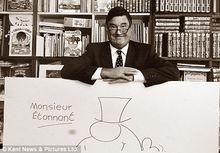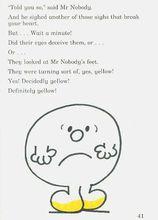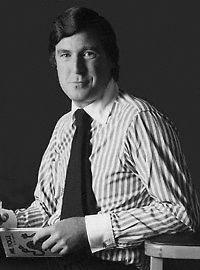簡介
Hargreaves出生在, Cleckheaton, 西約克, 英國,在高渣滓長大。他曾幫忙在他父親的洗衣店,做乾洗事務也在此一年前做過廣告。 但他原本的志向是當一個漫畫家; 1971年他寫第一個先生。 人書, 先生。 癢感. 他最初在找出版者時遇到重重困難; 但最終,他成功了。他的書在三年之內成為炙手可熱的兒童讀本,還售出一百萬個拷貝並在英國 BBC 的電視系列節目中大受歡迎.
由 1976羅傑放棄了他的工作。 在 1981年 小小姐 書系列開始出現。1983年被做了成一個電視系列節目,由 約翰Alderton, Pauline Collins講演。 雖然Hargreaves寫了許多其他兒童的故事,包括 Timbuctoo 二十五本書系列,約翰老鼠,並且Roundy和Squary預定,他認為他的 先生 系列所最滿意的作品。
家庭:妻子, Christine, Hargreaves有四個孩子, Adam, Giles, twins Sophie 和 Amelia。 早年有一個私生子名歐文。
在Hargreaves以後死於突發中風。1988年,其子亞當持續寫和畫先生。
資料背景
 1971年Mr. Tickle中創造了著名人物Mr. Men
1971年Mr. Tickle中創造了著名人物Mr. MenCharles Roger Hargreaves(羅傑·哈格里夫斯) (9 May 1935 – 11 September 1988) was anEnglish author and illustrator of children's books, notably the Mr. Men and Little Miss series, intended for very young readers. The books' simple and silly stories, with bright-coloured, boldly drawn illustrations, have been part of popular culture for over 25 years, with sales over 85 million worldwide in 20 languages.[1]
Hargreaves(羅傑·哈格里夫斯) was born in a private hospital[2] at 201 Bath Road, Cleckheaton, West Yorkshire, England, to Alfred Reginald and Ethel Mary Hargreaves(羅傑·哈格里夫斯), and grew up in High Lees, 703 Halifax Road,[2] also in Cleckheaton, outside of which there now is a commemorative plaque. He spent a year working in his father's laundry and dry-cleaning business before starting out in advertising.[1] But his original ambition was to be a cartoonist; and, in 1971, while he was working as the creative director at a London firm, he wrote the first Mr. Men book, Mr. Tickle. He initially had difficulty finding a publisher; but, once he did, the books became an instant success, selling over one million copies within three years. In 1975 it spawned a BBC animated television series called Mr. Men Show, Mr Tickle being voiced by Arthur Lowe.
By 1976, Hargreaves(羅傑·哈格里夫斯) had quit his day job. In 1981, the Little Miss series of books began to appear. It, too, was made into a television series in 1983, which was narrated by John Alderton, who, with Pauline Collins, voiced the Men and Misses, respectively. Although Hargreaves(羅傑·哈格里夫斯) wrote many other children's stories, including the Timbuctoo series of twenty-five books, John Mouse, and the Roundy and Squary books, he is best known for his 46 Mr. Men books and 33 Little Miss books.
With his wife, Christine, Hargreaves(羅傑·哈格里夫斯) had four children: Adam, Giles, and twins Sophie and Amelia. The first of the Mr. Men characters is reported to have been created when Adam asked his father what a tickle looked like: Hargreaves(羅傑·哈格里夫斯) drew a figure with a round orange body and long, rubbery arms, which became Mr. Tickle.
In his latter years Roger lived in Guernsey.
After Hargreaves(羅傑·哈格里夫斯) died of a sudden stroke in 1988, Adam continued writing and drawing the Mr. Men and Little Miss characters in new stories. However, in April 2004, Christine sold the rights to the Mr. Men characters to the UK entertainment group Chorion, for £28 million.
生平介紹
Hargreaves, (Charles) Roger (1935–1988), copywriter and children's author, was born on 9 May 1935 at 201 Bath Road, Cleckheaton, Yorkshire, the second of the four children of Alfred Reginald Hargreaves, then a woollen cloth manufacturer, and Ethel Mary, née Pickles; the family home was High Lees, Halifax Road, Cleckheaton. Hargreaves attended primary school in Goole (from 1940) and in 1947 became a pupil at Sowerby Bridge grammar school. His childhood interests were cricket and reading. A keen sense of humour was apparent from an early age, as was a talent for art (in later years he said his childhood ambition was to be a cartoonist). Hargreaves left school in 1953 to begin work in his father's laundry and dry-cleaning business but, after his national service call-up, was enlisted in the Royal Air Force (1955–7). At 6 feet 5 inches, Hargreaves was too tall for flight duties, and was assigned an office role in London. While Hargreaves was on national service his father died and the family business was sold.
After returning to Yorkshire in 1958 Hargreaves began work in Bradford as junior copywriter for Greenlys advertising agency, earning £7 10s. a week. In the following year he moved to London to further his career and in 1962 joined Service Advertising as senior copywriter. Here he worked on consumer brands including Suncrush (soft drinks), Dewar's (whisky), BP (petrol), and Senior Service and Manikin (tobacco), before rejoining Greenlys (by then Lonsdale Crowther) as copy chief of their London office in 1966. Two years later he moved to Foote, Cone and Belding as creative director, where he handled accounts for Fry's (confectionery), Watney's (beer), Gibbs (toothpaste), ICI (household chemicals), Rootes (cars), and BOAC (air travel). His final move was to David Macaulay Advertising (1969) as creative director and board member. During his advertising career Hargreaves was responsible for originating a number of notable slogans, including ‘Roll out Red Barrel’ (for Watney's), and ‘Emigrate to Canada Dry (for the sake of your Scotch)’ (for Canada Dry Tonics and Mixers). In 1970 he formed Slide City, a company producing photographic slides for the UK advertising industry. In its first year Slide City created and sold more than 39,000 slides.
On 12 March 1960 Hargreaves had married Margaret Christine (b. 1937), the daughter of Charles Leslie Heard, a farmer from Dorchester, Dorset. They had four children: Adam (b. 1964); Giles (b. 1966); and twins, Amelia and Sophie (b. 1970). The family lived at Westerham, Kent, and moved in 1971 to Woldingham, Surrey. Hargreaves wanted to spend more time at home with his young family, and his thoughts turned to writing and illustrating children's books. He had a clear understanding of what he wanted to create: stories that were short enough to be read in five minutes, with colourful pictures that the youngest children would find appealing, presented in small format books that were easy for little hands to hold.
In early 1971, while working on an advertising campaign for a corporate client, Hargreaves doodled a character with exceptionally long arms. He thought it could be adapted for a children's book. An oft-repeated story provides an alternative version in which the figure came about after Hargreaves asked his seven-year-old son Adam: ‘What does a tickle look like?’ The boy's reply is said to have given him the idea for a long-armed character. Attractive as this story is, Adam Hargreaves has no recollection of the incident, suggesting that the true genesis of his father's characters was a combination of many concurrent ideas.
A meeting between Hargreaves and Jack Thurman, director of the publishers Fabbri and Partners Ltd, led in August 1971 to the launch of six books called the ‘Mr’ series. The launch titles were Mr Bump, Mr Greedy, Mr Happy, Mr Nosey, Mr Sneeze, and Mr Tickle (Hargreaves's original doodled character), with books priced at 20 pence. A Fabbri press release (29 July 1971) identified the Mr books as ‘simple entertainment for children from age three to eight, whether readers or listeners. The “Mr” characters, whose adventures are humorous, all have normal human frailties with which different personalities may identify.’ Hargreaves later added that his lack of a formal art training meant that ‘I can't draw properly so I have to keep it simple. I'm much too lazy to write a novel, so short stories are ideal for me’ (interview for Boots Magazine, spring 1982). This concept was also, to some extent, the result of Hargreaves's advertising experience which used clarity and directness to appeal to a target audience. The Mr series was an immediate success, and six more titles were quickly added to the range. In 1974 the books were rebranded following a meeting between Hargreaves and Richard Culley of the licensing agency Copyright Promotions. It was Culley who proposed the name ‘Mr Men’ by which they became universally known.
The licensing of a children's character brand was in its infancy in Britain at this period. However, Hargreaves—alert to the commercial success of characters such as Snoopy—was sufficiently ambitious and business-minded to identify his creation's potential, and sold the rights to third-party clients for use on their products. Richard Culley began licensing the Mr Men property, and a range of partnerships was formed which saw Mr Tickle and friends appear on children's clothing, bedding, foodstuffs, stationery, toys, and ceramic items. In this way, Hargreaves's characters acquired new lives away from the books and gained widespread recognition which, in turn, fuelled demand for his titles. In response Hargreaves added new characters to the range, writing and illustrating a total of forty-three Mr Men books.
In 1975 a Mr Men cartoon series was screened by the BBC, narrated by the actor Arthur Lowe (twenty-six 7.5 minute episodes were made by Mister Films). The characters also featured during the 1980s in a Daily Mirror comic strip. In 1977 Hargreaves left advertising and devoted himself full-time to writing and illustrating the Mr Men books, as well as designing for the ever-growing range of merchandise which derived from the characters' success. A request from his American publisher led to the launch, in 1981, of the Little Miss characters, including Little Miss Tiny, Little Miss Bossy, and Little Miss Sunshine, specifically designed to appeal to young girls. Hargreaves created thirty books for this range. A Little Miss television series, narrated by John Alderton and Pauline Collins (thirteen 7.5 minute episodes, again made by Mister Films), followed in 1983. In addition to his Mr Men and Little Miss characters, Hargreaves also created several less well-known characters, notably Hippo, Potto, and Mouse (1976), and Timbuctoo (1978).
By 1981 some 31 million copies of the Mr Men and Little Miss books had been sold in the United Kingdom alone and, as the full effect of licensing the characters was realized (from an estimated 700 products), Hargreaves achieved the 1988 European licensing award ‘For outstanding contribution to the licensing industry’. In the world of children's licensed characters, very few creations prosper for more than five years and those that do, like Mr Men and Little Miss, become classics. Their success, then and now, lies in the age-old desire for enquiry into human nature. Hargreaves described familiar childhood situations that are as recognizable today as when he first devised them. Certainly his prose style can be stilted and repetitive, and his plots have little depth. Likewise his illustrations, which have a naïve quality and are bereft of detail, are essentially variations on a circle filled with solid, flat colour. However, Hargreaves's skill was to create characters which capture shared emotions: what child cannot fail to relate to the trips, falls, and slips of Mr Bump, be inquisitive about Little Miss Curious, or smile along with a character named Mr Happy? Their appeal also extended beyond children. In June 1983, for example, Mr Happy's image was adopted to promote the city of Glasgow, under the slogan ‘Glasgow's miles better’. The campaign, one of the best-remembered promotions of a British city, ran until 1989, and was given a second airing in 1994.
Between 1979 and 1982 Hargreaves and his family lived in Guernsey, and thereafter they settled at Sussex House Farm, Cowden, Kent. In 1987 he gave a piece of land to St Mary Magdalene's Church, Cowden, which adjoined his property. Hargreaves died, aged fifty-three, on 11 September 1988 at the Kent and Sussex Hospital, Tunbridge Wells, following a stroke. He was buried at St Mary Magdalene's Church, in the graveyard extension on land he had donated the previous year.
At the time of his death Hargreaves had sold an estimated 85 million books (translated into fifteen languages) in twenty-two countries. His estate continued to publish Mr Men and Little Miss books and stories after 1988, with new work, though credited to Roger Hargreaves, largely written and illustrated by his son, Adam. In April 2004 the Hargreaves family sold their interest in the Mr Men and Little Miss characters for £28 million (including £4 million for Mister Films) to the intellectual property company Chorion, who also own, among other properties, Noddy, the Famous Five, and Miss Marple. Chorion intended to ‘re-invent’ Hargreaves's characters for a new generation.
作品
 羅傑·哈格里夫斯
羅傑·哈格里夫斯With a name like his, it's no surprise that Mr Nobody has gone unnoticed for 25 years.He made a fleeting appearance in a limited-edition Mr Men hardback in 1985 but failed to make it into bookshops.
Now Adam Hargreaves, the son of the late Roger Hargreaves who designed the children's characters, has decided to give Mr Nobody his rightful place in their roster.
He is to bring out a Mr Nobody book in March, after finding the character in an archive.
Mr Nobody was initially published in 1985.
But it was only produced as a large-format picture book in a limited edition print run. It seems Roger Hargreaves chose to scrap the idea.
When Roger died in 1988, his son Adam Hargreaves continued his father’s work in writing and illustrating new stories.
He discovered Mr Nobody in the archives and - athough original images have been changed - the story remains the same.
The Mr Nobody character is unable to remember where he is from or who he is
It centres on Mr. Nobody - ‘somebody who sort of was, but wasn’t!’ - who is unable to remember where he is from, who he is, or what he should be doing.
Mr Nobody is now a full member of the Mr. Men and Little Miss clan.
The new edition, which is released in March, brings the total number of classic Mr. Men books to 47. The find is well-timed.
Next year, Egmont will celebrate the 40th anniversary since the first book, Mr. Tickle, was published in 1971.
Adam Hargeaves, who inspired the books when he asked exactly what a 'tickle' might look like, said: 'My father would be delighted that Mr. Nobody has returned to be enjoyed by new Mr Men fans. I am thrilled he has been found.'

